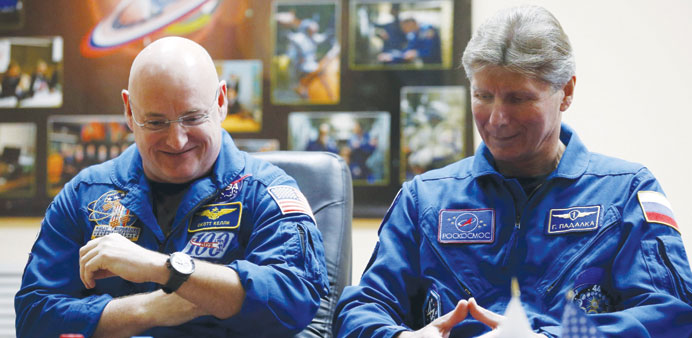Nasa astronaut Scott Kelly (left) and Russian cosmonaut Gennady Padalka, members of the 43 International Space Station crew, attend a news conference behind a glass wall at Baikonur cosmodrome yesterday. The crew is scheduled to travel to the International Space Station today.
By Christine Coester/DPA/Washington
A one-of-a-kind mission led by astronaut Scott Kelly will bring astronauts and mankind one step closer to exploring Mars.
While Kelly makes history by becoming the first US astronaut to orbit Earth on the International Space Station (ISS) for an entire year, his identical twin brother Mark, a retired astronaut, will do his part.
Mark’s feet, however, will remain firmly on Earth.
Today at 1942 GMT, a Russian rocket will launch Scott Kelly and Russian cosmonauts Mikhail Kornienko and Gennady Padalka to the ISS in a Soyuz spacecraft from the Russian launch station in Baikonur, Kazakhstan.
Kornienko will also spend a year in space.
Once aboard the floating laboratory 400km above Earth, Kelly and others will conduct research to provide clues on how long trips into outer space impact humans.
The Twins Study involving the 51-year-old Kellys includes 10 different experiments selected from more than 40 proposals submitted by prestigious universities in the US.
The goal is “expanding our envelope and understanding how people can live and work in space for longer periods of time,” Kelly told reporters in a teleconference.
The trip to Mars is a long one - at its best, about 260 days one way, Nasa says. Nasa is developing the technology and spacecraft needed to send humans to Mars in the 2030s, and needs more data about how a human being can survive that long in space.
With almost 100% identical DNA, Mark and Scott Kelly have the unique genetic blueprint that offers the rare opportunity to look at physical differences which may arise during Scott’s year in orbit.
“My brother and I are identical twins and as such, we have very similar DNA,” Kelly said. “Not exactly the same but very, very close.”
All humans are approximately 99.5% identical. That remaining half per cent accounts for all the diversity seen among humans.
The brothers are ideal candidates because their exceptionally similar DNA reduces the number of variables within the study. That means Mark will act as a control to which researchers can compare Scott.
“Any scientist will tell you this is only one data point,” Kelly said. “What we learn here is somewhat anecdotal, but it will give us a sense for areas that we need to investigate further.”
Researchers will follow up with more experiments and ultimately figure out what is needed “to get further away from Earth,” Kelly said.
The Twins Study investigations cover a spectrum of research focused on the impact of space travel on the human body, which Kelly noted is physically taxing.
Astronauts are exposed to high levels of radiation from cosmic rays, they experience bone and muscle loss, a weakened immune system and often have trouble with their vision.
Several studies will look for changes in DNA, such as whether cosmic rays cause premature aging by impacting the length of the protective shoelace-like tips found at the end of each DNA strand, called telomeres.
“Most of the experiments that compare us are genetic based, looking at the changes in our DNA, RNA and protein . over this year long period,” Kelly said.
Another study will look at how dietary differences and stressors impact the bacteria living in the twins’ digestive tracts.
Investigations will compare how the twins’ immune systems respond to a flu vaccine and whether increased pressure and fluid distribution within the skull, resulting from being in a weightless environment, impacts brain function and vision.
Most of the experiments will require blood, urine and faecal samples, while other tests will measure perception, reasoning and alertness.
In addition to the Twins Study, there will be nearly 400 different types of scientific experiments conducted at the station. Those experiments are focused on improving life on Earth or building systems that would allow humans to venture deeper into the solar system, Kelly said.
“We do a lot of other science on the space station,” Kelly said. “It’s all important to the future of our species as explorers.”
Since beginning his career in 1996, Kelly has participated in three space flights but none longer than six months.
The longest time spent in space was in 1995 by Russian cosmonaut Valeri Polyakov, who spent 437 days orbiting in the Mir space station.
The current study will expand on the Polyakov findings.
“We have a much better capability to do science and collect data than we did when those cosmonauts did those missions well over 15 years ago,” Kelly said.



